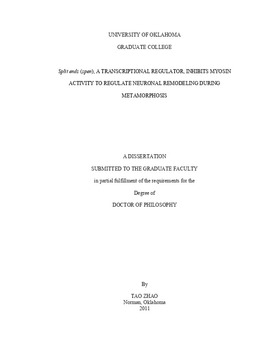| dc.description.abstract | Animal neurons dynamically change their morphologies in response to steroid hormone signaling to adapt to changing environments. The molecular mechanisms underlying animal neuronal remodeling, however, remain largely unknown. Metamorphosis is an important developmental stage in insects when crawling and feeding larvae transform into reproductive and flying adults. During this period, many insect larval neurons undergo dramatic morphological and functional alterations. These neuronal changes are regulated by a arthropod-specific steroid hormone, 20-hydroxyecdysone (ecdysone). Research on the metamorphic remodeling of insect neurons, has provided insights into the general neuronal remodeling process. During the early stage of metamorphosis, the larval neurons prune their projections and then grow out adult-specific neurites. A group of Drosophila melanogaster (fruit fly) neuroendocrine cells, the crustacean cardioactive peptide (CCAP) neurons, experiences metamorphic remodeling, and I used these neurons to dissect the molecular mechanisms controlling this process. The CCAP neurons mainly produce two neuropeptides, CCAP and bursicon, to control insect molting-related behaviors, ecdysis and wing expansion. Functional disruption of the CCAP neuron remodeling leads to defective wing expansion in adults. In a genetic screen, thousands of genes were mis- or overexpressed in the CCAP neurons. The genes that produced strong wing expansion defects were identified. Fourteen of the identified genes specifically inhibited the outgrowth of adult-specific neurites during metamorphic remodeling. One of these, split ends (spen) was selected to identify the molecular pathways affected by its overexpression. I performed a deficiency modifier screen to identify mutations that modify the outgrowth defects induced by spen. A mutation of Mbs, the gene encoding the Myosin binding subunit, moderately suppressed the outgrowth defects. Since Mbs negatively regulates myosin II activity, the results suggested that spen overexpressin suppressed myosin II activity. Another myosinmodulating signaling pathway, Rac1-PAK, was also tested to confirm the observations. The Rac1-PAK signaling pathway positively regulates myosin II function, and this pathway suppressed the neurite outgrowth defects induced by spen overexpression. Furthermore, down-regulation of spen activity strongly rescued the wing expansion and neurite growth defects resulting from disrupted Rac1-PAK signaling. These results strongly support a model in which spen functions antagonistically with myosin II to regulate neuronal outgrowth during metamorphosis. | |
